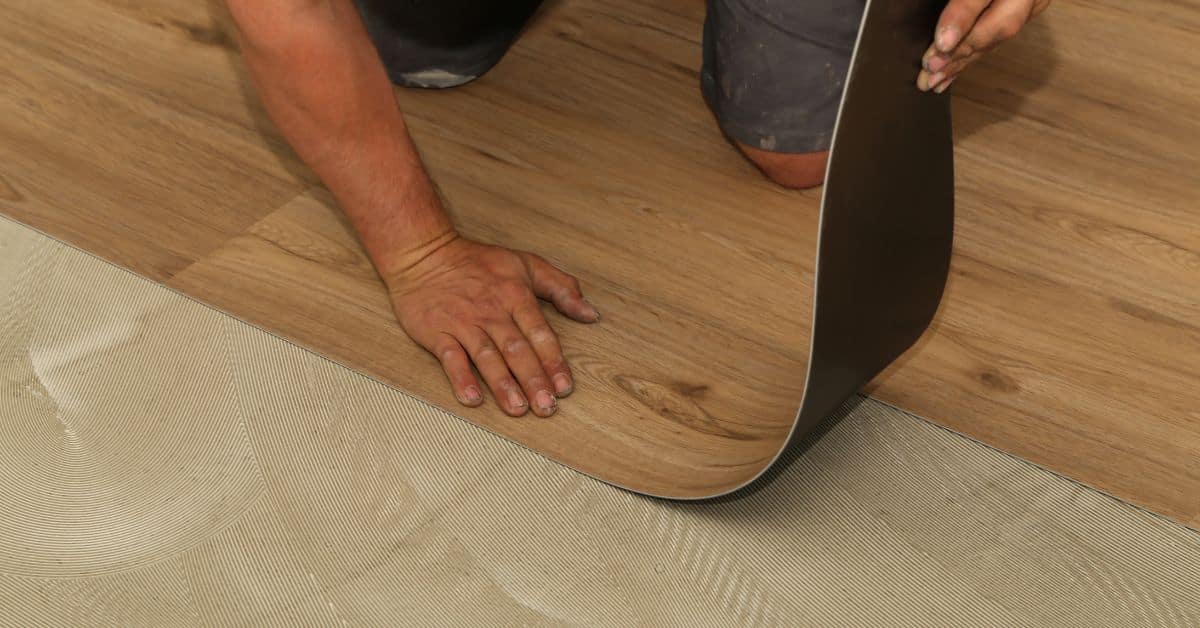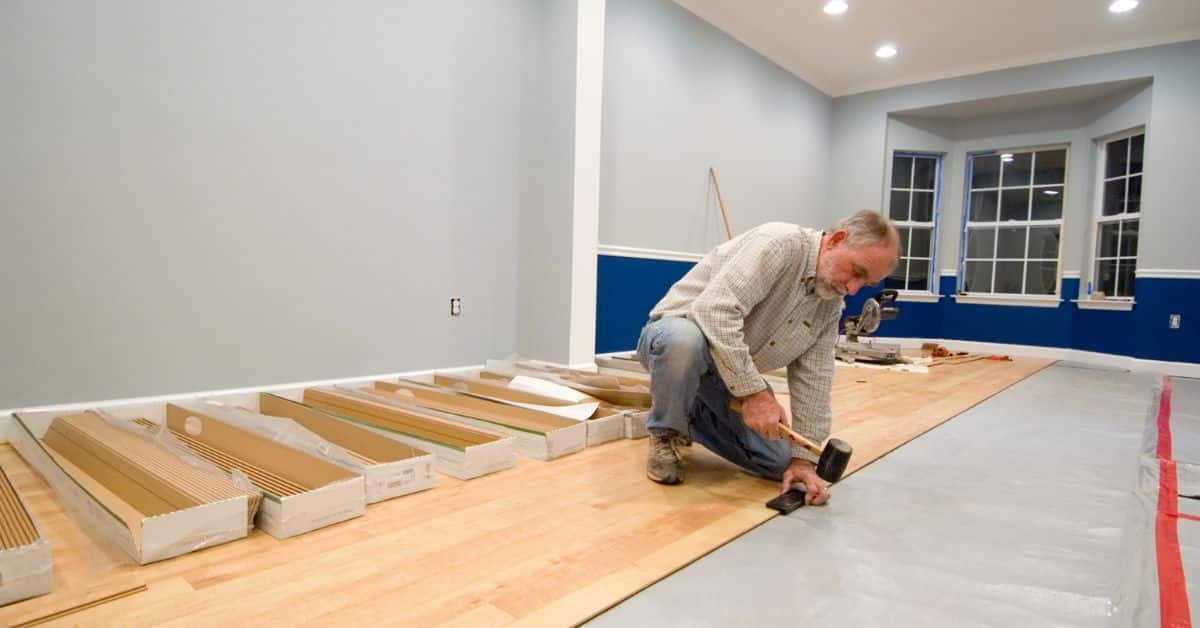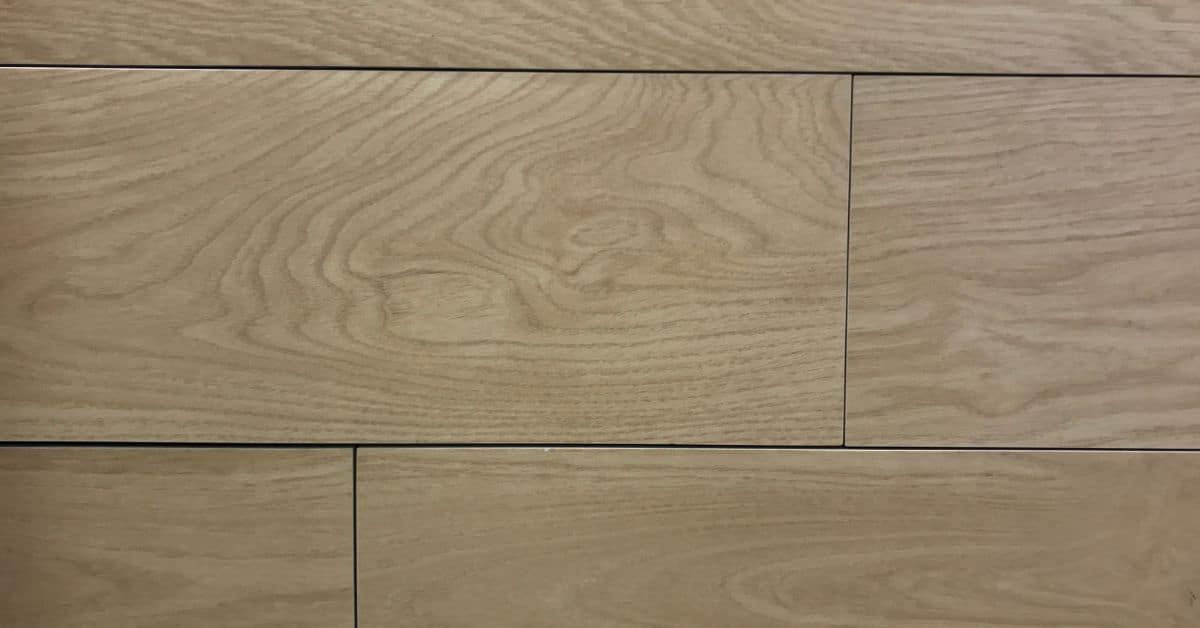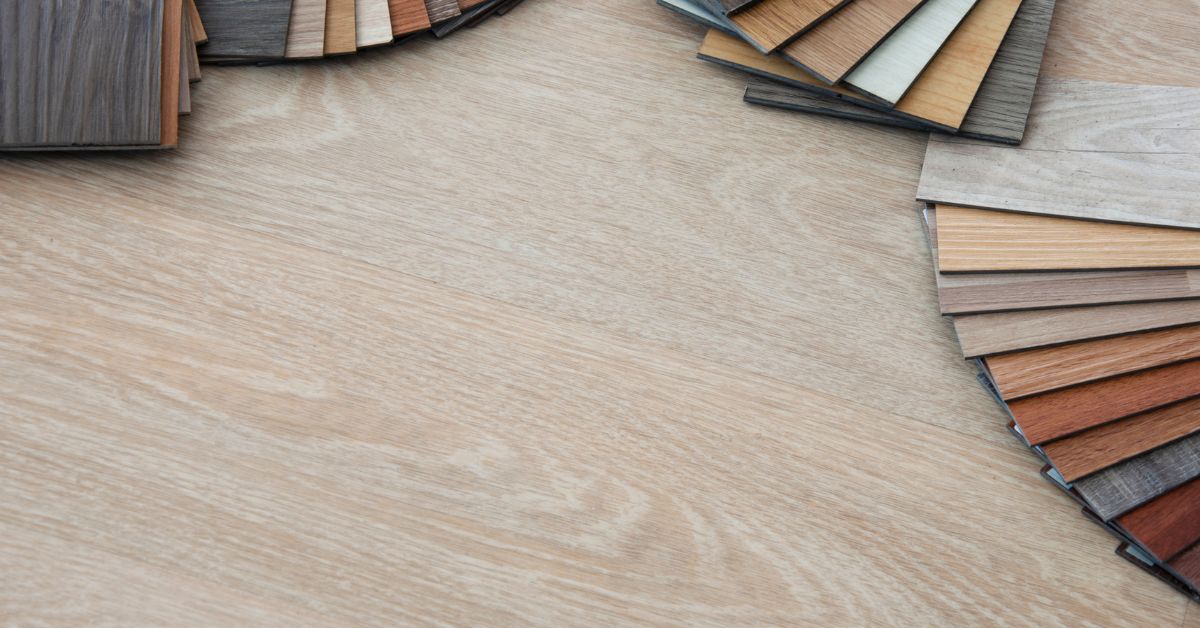The best flooring for rental properties is ceramic tile in most cases. However, it depends on the property. So, landlords face a big decision when choosing which floors to install.
We know researching flooring is probably not at the top of the list of things you want to do. So, we did it for you. This guide contains valuable information like shopping and buying tips, top flooring choices, pricing, and how to depreciate floors to claim a deduction on your taxes.
When selecting a flooring option, you must look for a few things. Otherwise, you will be changing flooring constantly, which takes time and money.
Rental units that are visually appealing rent faster. So, you must ensure your entire rental is clean and fresh. You also want to ensure that each room's aesthetic is cohesive with the rest of the house.
You want the option you choose to be easy to clean and maintain. Giving a tenant flooring that is challenging to clean can lead to insect infestations, especially in older multifamily homes. So, it is essential that the renter can clean up messes quickly.
You should also avoid flooring that requires special care or cleaning. For example, wood floors are beautiful, but using a regular vacuum and mop will damage them.
The longer your flooring lasts, the less frequently you will have to change it. In most mid to high-grade apartments, the carpet is changed annually, if not sooner, between tenants. If a tenant is living in a home for a while, they may also request new flooring if theirs is worn out or dirty. So, you want to choose something durable that looks new for a long time.
Tenants are tough on flooring and nearly every other part of rentals. So, it is important to find an affordable option. However, when it comes to flooring, you need to factor in more than the initial cost.
If possible, you should choose a water-resistant option, especially in wet areas. Carpeting is not waterproof. If you get carpet wet, you can quickly dry it without causing significant damage.
Other flooring types, like engineered wood, will not fair well if you get them wet. While you may take care of beautiful floors in your home and appreciate them, tenants are much less likely to take care of your property the same way. So, to avoid a headache, it is better to install options harder to damage.
You will want to break the flooring cost down into a monthly or yearly figure to compare the long-term affordability. Certain flooring types have a lifespan which you may find on the box. Most non-carpet options last for at least five to ten years.
In this example, we will use a vinyl option that should last for five years. The average cost of flooring a 1,000 sq ft apartment with vinyl is between $3,000 and $7,000.
So, over the five-year life of the floor, your investment will cost between $50 and $116 per month and between $600 and $1,400 per year.
While not every flooring type is an excellent choice for investment properties, several good alternatives exist. Each offers different pros and cons, and not every flooring type is appropriate for all homes.
Vinyl tile flooring is typically the least costly and easiest to install. Vinyl could work for landlords looking to replace flooring in a small room. However, improperly installed vinyl planks can start to lift. As they do, dirt, crumbs, and other debris get trapped underneath.

So, if you decide to install vinyl floors, make sure you know what you are doing or hire someone who does. If vinyl is laid correctly, it is attractive and affordable. However, you will need to replace it every five to ten years.
Hiring a professional company to install vinyl floors will cost between $4 and $6 per square foot.
Bamboo floors have become more popular because they are inexpensive and eco-friendly. It takes much less time to grow bamboo than other types of wood like oak, cedar, spruce, etc. The availability of bamboo makes producing these floors much less costly.
They have the appearance of hardwoods and are similar to other wood flooring varieties. While they are prone to scuffing and scratching, bamboo is slightly harder and less porous. Nevertheless, bamboo flooring is better for areas where water damage is less common, like living rooms, dining rooms, and bedrooms.
If you install wood floors, you must properly seal them. Unsealed wood floors are much more absorbent, and they stain more easily. So, it is worth the extra money or effort to seal them.
The cost for installing bamboo floors ranges significantly depending on the type you install and the size of your space. However, you can expect to pay between $1.50 and $11 per square foot for bamboo floors.
Carpeting is the most common flooring type in rentals because it is inexpensive, offers numerous styles, and is relatively durable. However, many luxury property managers are moving away from carpets and opting for more durable, longer-lasting options that consumers prefer.
Like other options, the cost of carpeting a home depends on the quality of the materials you buy. However, it typically costs between $3 and $6 per square foot.
Laminate flooring comes in various styles, shapes, sizes, and prices. Some laminates look like tile, wood, or natural stone, and they come in different thicknesses and shapes too.

When installed correctly, laminate floors are spill-proof, attractive, and inexpensive compared to other options. Laminates are very popular amongst landlords in bathrooms, kitchens, laundry rooms, and hallways. The average cost for installing laminate floors is $3.80 to $4.80 per square foot.
Porcelain tile is one of the more challenging options to install. However, it lasts three to four times longer than other floors. If you buy an investment home and install tile flooring throughout, you will likely never have to replace the floors again.
Some renters do not like homes with all tile floors, but many others appreciate that they are easy to clean and hard to stain.
Stained concrete is not the right choice for some properties. Concrete floors can add to the decor in lofts or contemporary homes. Like tile, stained concrete should last much longer than other floors. However, you may have to reseal or acid wash it from time to time to preserve the appearance. Staining concrete will run you between $7 and $15 per square foot, depending on the type of acid wash you want and the installer.
One of the unique flooring choices you can select is porcelain tiles that look like wood. These tiles look incredible in almost any space and last almost indefinitely.
Another attractive feature of these floors is the pricing. They provided a high-end look with a price of between $1.50 and $4 per square foot for the tiles.
Tile floors are by far the most durable. When you install tile, you should not have to worry about replacing it for many years, if ever.
There are some homes or areas where you can't install tiles. In these areas, carpet or vinyl is a suitable option.

Tile is extremely low maintenance, hard to stain, and when appropriately laid, nearly indestructible. You can use almost any cleaning method without damaging it, and it does not trap food, crumbs, dander, and dust like carpet.
There are flooring types that you want to avoid using in large upstairs spaces. They create an echo in the area and amplify the sound in downstairs units. So, you want to install something that absorbs sound. Carpet or bamboo is an excellent choice for upstairs units. Tile is still a good option in bathrooms, kitchens, laundry rooms, and closets.
It can be more expensive to cool homes with floors that stay cooler in colder climates, like tile or concrete. So, bamboo or carpet is an excellent choice if you own rentals in states with cold winters.
Overall, ceramic wood plank tiles offer the most appealing style, durability, and affordability. Having the tiles installed will cost more than installing carpet or laminate floors. However, it will last for much longer.
Once you install tile, you do not have to worry about replacing flooring for many years.
Aside from affordability and durability, there are a few other things to factor into your decision.
Choosing a neutral flooring color is vital. You want anyone to imagine themself living in the home when they walk in. If you install a blue carpet and a potential tenant has furniture that does not match, they will probably not take the apartment.
When you find a tenant, they will not be willing to pay as much rent because the home is not aesthetically pleasing. Furthermore, your turnover rate may be higher. People are less likely to move out of a home they enjoy.

The installation process is fundamental if you do the installation yourself. However, you will want to consider the method and timeframe, no matter who is doing the work. The longer it takes to complete the floors, the longer you have to wait to make the unit ready and get it rented.
Furthermore, if you have to repair a small section of flooring, you will want to ensure that it is an easy task, especially if you choose an option that you will need to replace more frequently.
Some condo associations have restrictions that do not allow top-floor residents to have tile floors. In these units, owners can only install tile in the home's wet areas, like the kitchen, utility room, and bathrooms.
Downstairs, neighbors can hear more sound from walking or moving objects when an upper unit has tile floors. As a landlord, you do not want your tenant to have issues with their downstairs neighbors. So, it is a good idea to avoid tile in upstairs condos.
Floors make a massive difference in a space. Just imagine how you feel when you walk into a home where the entire home matches and the color scheme is relaxing. It makes you happier, so you want to stay longer.
Installing unique flooring that renters appreciate will also help you to bring in more rent. For example, a renter is more likely to pay you $50 to $100 more per month for a rental with new floors over a place with dingy carpets.
If you have basic home repair DIY skills, you can likely install your floors yourself. However, if you want them to last, you must follow specific installation steps.
It might seem obvious, but the first thing you need to do before installing new flooring is to remove the old stuff. If you are taking out carpet, you will want to pull it up in the corner. Once you start pulling the carpets up, they should be easy to take out.
If the tack strips are in good condition, you can leave them. However, if there is significant damage, you will likely want to replace them as they help to keep the carpet in place.
After you remove the old floor coverings, you need to clean the bare floors thoroughly. Remove any debris and vacuum them.
After removing all debris, you can use a floor stripper to remove any residue or glue. Using a floor stripper is always a good idea. It ensures that the base floors are clean and that the new flooring will lay properly.
You can lay out your flooring before you begin putting it in to ensure that you are happy with the pattern or placement. If you use tile, you will want to place the tiles on the floor with spacers.
On all flooring jobs, you have to cut pieces to fit. Certain pattern types do require more custom-cut parts, though. So, if you are new to this job, you may want to try a straight pattern first before you attempt to install diagonal flooring.
After you have the flooring pattern set and the pieces are all cut, you need to glue the flooring in place. If you are installing carpet, you have to stretch it and affix it to the tack strips.
After installing the tiles, you need to fill in the grout. You will spread the grout between each tile and ensure it is even. You must then wipe off the excess and allow the grout to dry.
After you finish gluing and grouting the floors, you need to let them dry before you do a lot of walking on them or move anything across them. Luckily, flooring glue and grout dry quickly, so if you let them cure overnight, they should be ready in the morning.
When your flooring job is complete, you need to seal it. Sealing your floors prevents dirt and food particles from getting between the tiles or planks. It also makes the floor more water-resistant and protects it from stains.
Home Depot and Lowe's are convenient national building material stores that offer competitive pricing. However, you may be able to get a better deal at a flooring liquidation company if you live in a large city. If you live in a smaller town, you may be able to order your flooring online and have a local company do your installation to save money.
Many sites offer free shipping for flooring if you spend enough money. Buying the materials yourself rather than having a contractor order it can cut down on the cost of materials.
If you own many rentals, it is an excellent idea to negotiate pricing with a local supplier for materials you buy regularly. You should also consider using the same flooring, paint, cabinets, and other upgrades in all of your rentals. That way, you do not end up with a bunch of excess material after jobs, and you have what you need when you need to do repairs on other units.
Damage to flooring can be challenging for landlords to collect unless there is proof of the condition before the tenant moves in. Additionally, if your renter lived in the unit for a long time, courts may not hold them responsible because flooring only has a useful life of between five and ten years.
If you recently changed the floors and your tenant damaged them, you can withhold all or part of their security deposit without going to court. However, you need to provide them with a letter of notice outlining why you are keeping their deposit.
Choosing a flooring option that is difficult to damage is the best preventative measure you can take. Each time you lease a unit, it is also a good idea to take pictures of the condition before the tenant moves in and ask them to fill out the tenant move-in inventory list.
On it, the tenant can list any damage. They return it to you so you can keep it on file. That way, if there is any damage, you know it is not their fault.
Before you decide on floors for your rentals, take a look at the answers to the most frequently asked questions about flooring by landlords.
Carpet is a good option for rentals but is not best in high moisture areas. In wet areas, tile or laminate floors are a longer-lasting option. Landlords must also replace carpets every few years or sooner, depending on wear.
The useful life of carpets depends on the quality. In a private home, carpet can last for 15 to 20 years if you properly care for it. However, landlords can expect rugs to last for around five years in rentals. When carpets begin to wear, tenants will want you to replace them or discount the rent.
Flooring is a capital expenditure in rental units. It adds value to your property. So, it is not fully tax deductible when you purchase it. Instead, you will need to determine the estimated life of the flooring and prorate the entire purchase over that period. You can then deduct the yearly amount in the form of depreciation each year during the useful life of your flooring investment.
The formula you use to depreciate flooring depends on the type. You can depreciate carpets and floors that you have to replace frequently over five or ten years. However, you depreciate longer-lasting flooring over 27.5 years.
If you pay $5,000 to install a new carpet in a rented home, you will divide $5,000 by five years, and your yearly depreciation comes to $1,000. So, you can write off $1,000 in depreciation for the carpet each year.
For tile floors that cost $10,000 to install, you would divide the cost by 27.5 years, and the total yearly depreciation would be $363.63.
The best flooring for rental properties depends on each landlord's preferences, market, and budget. In low-income rentals, you may want to put vinyl in the closets and pantry because they will suffice, and in some areas upgrading a home does not increase the rent you can generate.
However, in most cases, investing in a long-lasting, attractive tile will give you the most for your investment. Once installed, these floors will usually last the entire time you own a rental. So, you never have to worry about choosing flooring again.
We encourage you to share this article on Twitter and Facebook. Just click those two links - you'll see why.
It's important to share the news to spread the truth. Most people won't.